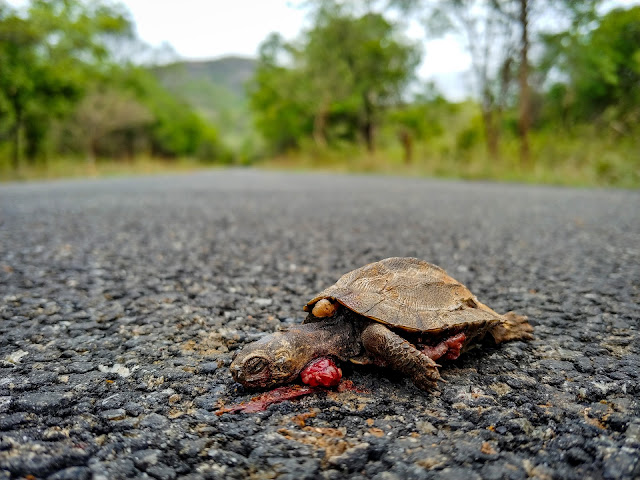Eyes on the Road, Please!
Vinod M Kumar
 |
| Indian Black Turtle (Melanochelys trijuga) |
We all must’ve heard the phrase “Keep your eyes on the road”. But have you ever literally did that?
I started doing that a year back when I was volunteering for ATREE-ACCC’s research work inside the Kalakad-Mundanthurai Tiger Reserve aka KMTR,
India’s southernmost tiger habitat. ATREE has
been assessing the impact on the biodiversity of the areas surrounding the
famous Sorimuthu Ayyanar Temple for more than a decade now. The temple famous
for the Aadi Amavasai festival is situated on the banks of the perennial river,
Tamiraparani. Every year during the festival, the temple attracts more than one
lakh devotees from all parts of the state. We were monitoring the impacts on
wildlife occupancy, water quality, socio-economic aspects among many other
things. For this blog, I’ll stick to the roadkill part of the monitoring for now. With more than a
lakh people visiting the temple, an equal number of vehicles also ply the roads
inside the reserve over a short span of five days. This puts enormous pressure
on the animals that inhabit the areas surrounding the temple. Our work was to
record the number of road mortalities along four road sections in two phases
i.e. pre-festival and during the festival.
Every morning each
team would survey the road sections for the roadkills. In each survey, it was
heartbreaking to see many little yet valuable lives being lost on roads because
of careless driving. Most of the roadkills are of reptiles. And the reason is
obvious. As reptiles are ectotherms it depends upon external sources to
regulate their body temperature. The roads which radiate heat is an ideal place
for the reptiles to bask. Some also lose their lives while crossing the roads
which traverse through their habitats. I did not come across any roadkill of
mammals during the survey. But during previous years of monitoring roadkills of
mammals like Common Palm Civet (Paradoxurus
hermaphroditus), Indian Gerbil (Tatera
indica) have been recorded.
 |
| Bronzeback Tree Snake (Dendrelaphis tristis) |
The roadkills mostly include snakes, turtles,
lizards and many other invertebrates. As this period is also the breeding
season for many animals, increased roadkills in a short period of time
ultimately threaten their survival. The species I encountered the most as
roadkill were Indian Black Turtle (Melanochelys trijuga)
mostly juveniles and some colubrid snakes like Bronzeback Tree Snake (Dendrelaphis tristis) and Russell’s Kukri (Oligodon
taeniolatus). One roadkill worth mentioning was of
the Indian Rock Python (Python molurus) which is a
Schedule I species protected under the Wildlife Protection Act of 1972.
 |
| Indian Rock Python (Python molurus) |
The findings of
ATREE over a decade long monitoring reveals that the road mortalities includes
more than 50 species of animals and the roadkills are ten to fifteen times more
during festival days when compared to pre-festival period. As the density of
vehicles entering the forest increases during the festival, the roadkill also
increases drastically. More than half of the mortalities were of the nocturnal
animals since there was no night traffic ban during the festival days. This
finding among many other things later convinced the district administration and
the forest department to take some positive measures to regulate the vehicular
traffic during the festival. Now the private
vehicles are no longer allowed to enter the reserve during the festival days.
They are stopped two days before the festival and also not allowed for two days
after the festival. Night traffic ban is in force during the festival days.
Only public transportations like buses at timely intervals are allowed during
the festival days. As a result, the roadkills have significantly reduced if not
completely.
 |
| Keeled Grass Skink (Eutropis carinata) with its eggs |
This is one
success story from KMTR. But still every day countless lives are being lost on
roads all over the country. Roadkills are inevitable but they can be minimised.
And the solutions are very simple. Wildlife corridors are suggested as solutions for the roadkills inside the protected
areas. These are like bridges for the animals to cross linear infrastructures passing through their habitats. Also if we follow the so-called
defensive driving techniques such as driving slowly & carefully, keeping our eyes
on the road, we can effectively reduce the roadkills to a certain extent.






Good one vinoth
ReplyDeleteglad that institutions like ours are reflecting so much sensitivity and concern. compliments to the entire ATREE team for the wonderful work being done.
ReplyDeleteLet people be aware of these
ReplyDelete